Vanderbilt University Native Meadow flourishing with collaborative research projects
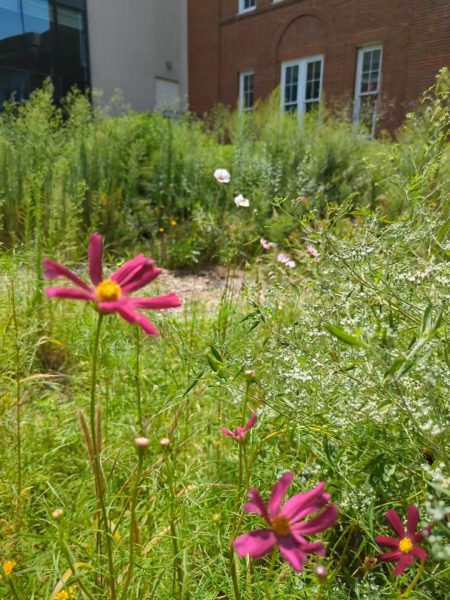 Tucked behind the 6 Magnolia Building on Vanderbilt’s Peabody Campus is what might look to some like a lush garden of weeds. In reality, it’s a strategic Native Meadow full of pollinator-friendly plants.
Tucked behind the 6 Magnolia Building on Vanderbilt’s Peabody Campus is what might look to some like a lush garden of weeds. In reality, it’s a strategic Native Meadow full of pollinator-friendly plants.
Funded by the Vanderbilt Green Fund in 2021, students proposed filling a meadow with plants native to the Tennessee/Nashville area to increase pollination and biodiversity and support soil health on campus. Many of the research projects within the meadow are supported by and funded by Vanderbilt Faculty. The Curb Center for Art, Enterprise, and Public Policy funded the signage, and the Green Fun supported the planting of the meadow and the monitoring equipment.
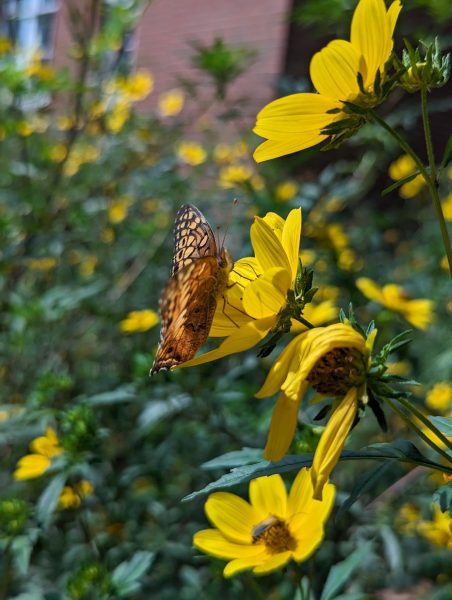 Since its inception, the meadow has flourished, and many faculty, staff and students have found ways to collaborate and interact with the space. Like other natural spots on campus, this meadow is thought of as a ‘living lab.’ It is an example of teaching, research and learning aspirations intersecting with university values around sustainability and stewardship of the campus environment.
Since its inception, the meadow has flourished, and many faculty, staff and students have found ways to collaborate and interact with the space. Like other natural spots on campus, this meadow is thought of as a ‘living lab.’ It is an example of teaching, research and learning aspirations intersecting with university values around sustainability and stewardship of the campus environment.
Follow @futurevusustainability and @vutrees on Instagram to learn more about this program.
Soil Health Research
Researchers, including faculty, undergraduates, middle and high school students, are monitoring the meadow to learn more about soil microbial activity, moisture levels and impact of the urban island effect on the area. A School for Science and Math (SSMV) at Vanderbilt class is taking core samples to learn more about soil health and its moisture under the direction of Chris Vanags, the director of the Peabody Research Office and a research assistant professor in the Department of Earth and Environmental Sciences, and SSMV program instructors.

Allison Walker, assistant professor of biological sciences and chemistry, is collaborating with Vanderbilt students to conduct a genetic analysis of the soil. The research in the Native Meadow contributes to Walker’s research, which is focused on:
- Developing algorithms that predict natural product activity from the biosynthetic gene clusters that produce them
- Using machine learning to investigate regulation of natural product production
- Developing tools to guide the engineering of biosynthetic gene clusters to produce novel natural product-like molecules
- Developing machine learning tools to design natural product-like inhibitors of protein-protein interactions
Soil Your Undies
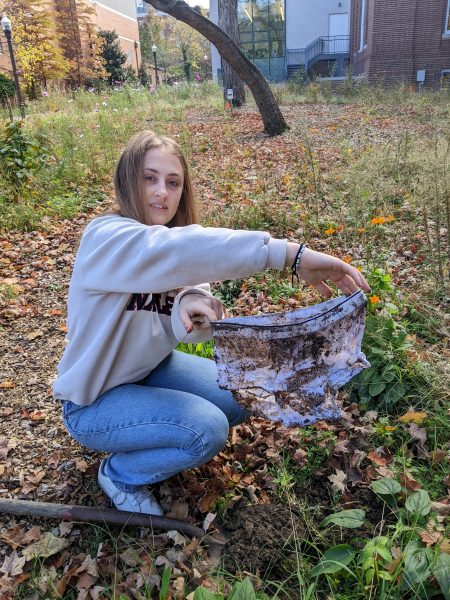
The “Soil-Your-Undies Challenge” is an ongoing research project that plants white, 100 percent cotton undies in the ground. After 60 days of being buried, researchers can collect soil health information based on the decomposition of the material. This project isn’t limited to the native meadow and other locations on VU’s campus—anyone can participate to learn more about the soil health in their home yard.
Spearheaded on campus by Vanags, and in collaboration with the ASCEND Initiative at Vanderbilt University and the Tennessee Environmental Council, the challenge was originated by Oregon farmers to develop more understanding about soil microbes, land management practices and carbon sequestration toward healthy and resilient soils.
“I love having students involved in the project,” Vanags said. “For me it’s a rare experience for a student, particularly in an urban setting, to be able to immerse themselves in what I consider a very tranquil environment that also has a lot of educational opportunities to it. I absolutely love that aspect of it.
“So part of this [project] is not just about science, but learning to observe. There is a great opportunity here to improve well-being. Being a scientist means you are observant, and observant means you are present, and that has a really positive impact on wellness. I hope that part of this [project] is a place for people to retreat, observe things and take a moment—go sit in one of those Adirondack chairs and think about things.”
PhenoCam
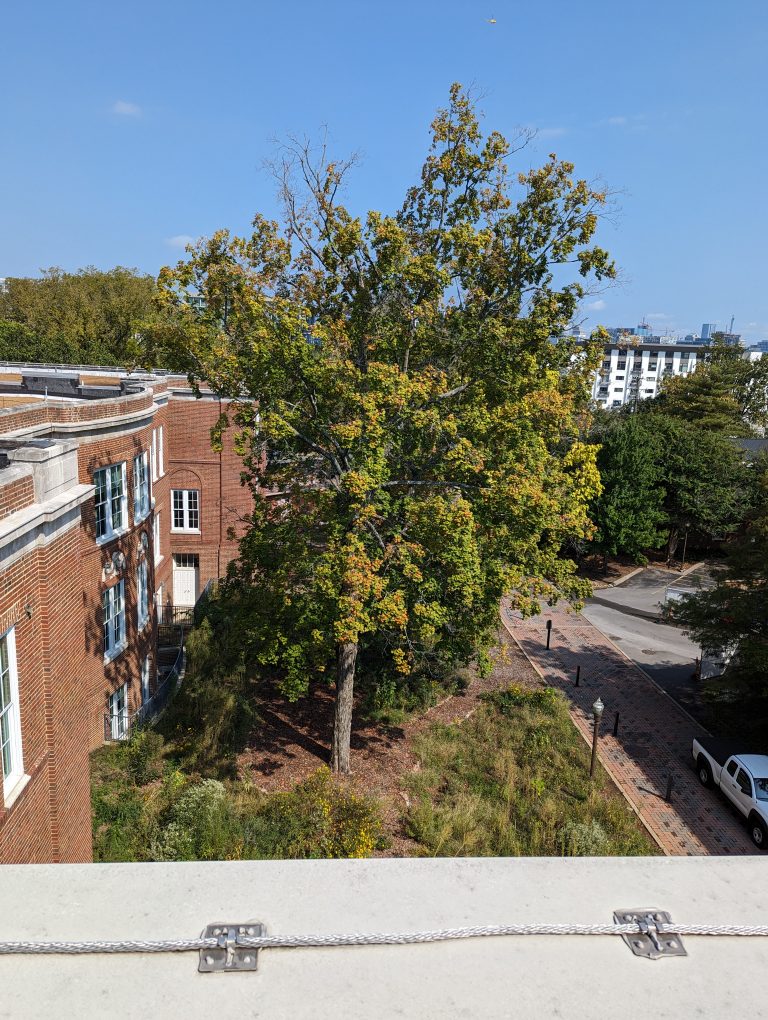
In 2023, a PhenoCam was installed overlooking the Native Meadow to study the relationship between the climate and the periodic events in biological life cycles of the trees and the plants. The cam and its data are overseen by Lin Meng, assistant professor of earth and environmental sciences, and her team.
The PhenoCam Network was established in 2008 by Northern Arizona University to use imagery from networked digital cameras to track phenology in a diverse range of ecosystems across North America and around the world. Today, there are over 700 sites, including the camera at the Vanderbilt Native Meadow.
Art Inspiration

After an initial conversation with Vanags, Professor Angus Galloway from the Art Department began collaborating with him on how to take learning outside the classroom, creating a mobile learning environment where students could explore new places on campus to activate their imaginations.
“Where clearly there is a structure to layout and the plants and the planting, this space is just able to grow—and the plants within the space just get to go where they need to go, which is great,” Galloway said. “So I was like, ‘You know, my students should come here.’ And they should do a project taking what they have learned in class and fusing it with this meadow—but only after they have confronted it, learned more about it. And each student really took it their own direction.”
The students spent time among the pollinator plants and walked the mulched pathways, and over many weeks they created a diverse set of art pieces inspired by nature. This initial project inspired Galloway to incorporate the meadow into future classes, including another group of students using inspiration from the meadow to create artwork and homemade paper. The project titled “Paper Experiments” is on display in the Peabody Fireside Room.
This initial project inspired Galloway to incorporate the meadow into future classes, including a new collaboration with SSMV instructor Dr. Menton Deweese and students to use inspiration from the meadow to create artwork using patterns found in nature and explore the science behind pigmentation and paper making. The project titled “Paper Experiments” is on display in the Peabody Fireside Room.”
Making Music
Jonathan Rattner, associate professor and director of undergraduate students in the cinema and media arts, uses filmmaking to dive deeper into the idea of sensory experiences as a part of storytelling. After talking with Vanags and learning about the Native Meadow, Rattner began thinking about how to connect more with the natural world, including with plants and trees. He attached a synthesizer to plants in the garden, and he lets the plants do the talking and create music.
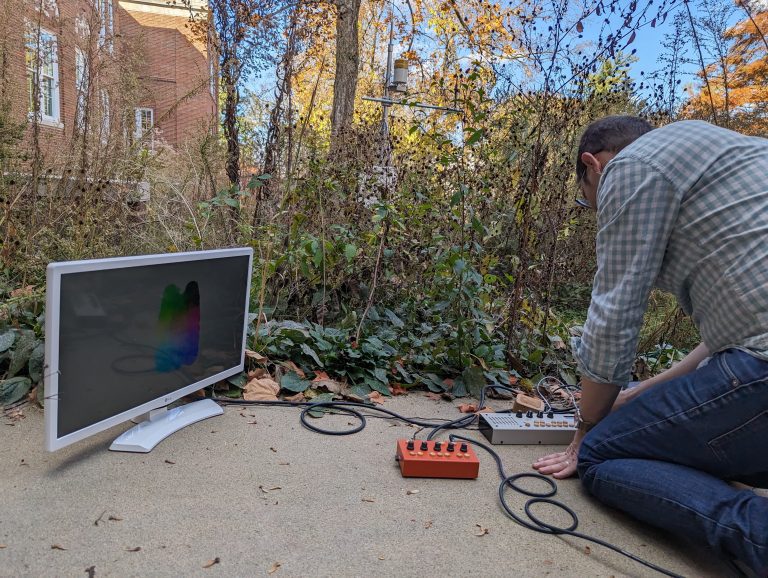
“Some people look at the plant stuff and think it is silly because it is not really speaking or making music, but to me it is a sensory thing. It is a way of listening in a new way, experiencing the plants in a new way. And, arguably, that actually changes the way we interact with it,” Rattner said. “The hope is, and the plan with the garden, is to connect some more focused technology so we know exactly what they are focusing on—like the heat, for example—so we can track data.”
The Native Meadow is open to the public. If you visit, share your photos and videos with @FutureVUSustainability on Instagram for a chance to be featured on the account.
